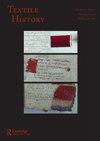认识到苏格兰针织品行业对机器和手工的共同依赖
IF 0.1
2区 社会学
0 HUMANITIES, MULTIDISCIPLINARY
引用次数: 2
摘要
自18世纪末以来,苏格兰针织纺织品的经济和文化知识是由对立的范式构成的。工艺研究将编织视为一种传统做法,重点研究手工编织机的技术和设计。另一方面,工业范式主要是对工厂生产的研究,将手工编织视为一种过时的非经济实践,被机械化所取代。本文分析了战后设得兰的针织品生产,以展示如何修改该框架的两极性,以突出该行业两个部分的明显相互联系和相互依赖。它还挑战了假设手工生产自动被机器生产取代的解释。自19世纪中期以来,针织一直保持着手工工艺和工业过程的双重身份,因此为弥合这些脱节的历史提供了一个案例研究。本文章由计算机程序翻译,如有差异,请以英文原文为准。
Recognising the Co-dependence of Machine and Hand in the Scottish Knitwear Industry
Knowledge of the economy and culture of knitted textiles in Scotland since the late eighteenth century is framed by opposing paradigms. The study of craft regards knitting as a traditional practice and focuses on the techniques and designs of the hand knitter. The industrial paradigm, on the other hand, is dominated by studies of factory production that subordinate hand knitting as an outmoded and non-economic practice superseded by mechanisation. This article analyses the production of knitwear in post-war Shetland to demonstrate how the bipolarity of that frame needs to be modified to highlight the manifest interconnectedness and mutual dependence of the two parts of the sector. It also challenges interpretations which assume craft production is automatically superseded by machine production. Knitting has maintained a dual identity as a hand craft and an industrial process since the mid-nineteenth century and thus provides a case study for bridging these disconnected histories.
求助全文
通过发布文献求助,成功后即可免费获取论文全文。
去求助
来源期刊

TEXTILE HISTORY
HUMANITIES, MULTIDISCIPLINARY-
CiteScore
1.00
自引率
0.00%
发文量
0
期刊介绍:
Textile History is an internationally recognised, peer reviewed journal and one of the leading publications in its field. It is viewed as an important outlet for current research. Published in the spring and autumn of each year, its remit has always been to facilitate the publication of high-quality research and discussion in all aspects of scholarship arising from the history of textiles and dress. Since its foundation the scope of the journal has been substantially expanded to include articles dealing with aspects of the cultural and social history of apparel and textiles, as well as issues arising from the exhibition, preservation and interpretation of historic textiles or clothing.
 求助内容:
求助内容: 应助结果提醒方式:
应助结果提醒方式:


